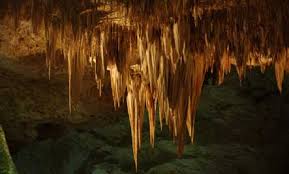stalactite
英 ['stæləktaɪt]
美 [stə'læktaɪt]
stalactite 钟乳石来自拉丁语 stalactites,钟乳石,向下悬垂的石柱,来自希腊语 stalaktos,滴落,滴出,来自 stalassein,滴,流淌,来自 PIE*stag,滴,渗出,词源同 stagnant,instill.拼写比较 rule,regulate.
- stalactite
- stalactite: [17] A stalactite is etymologically something that ‘drips’. The word was coined in modern Latin as stalactītēs, based on Greek stalaktós ‘dripping’, a derivative of the verb stalássein ‘drip’. Also derived from stalássein was stalagmós ‘dropping’, which formed the basis of stalagmite [17].
- stalactite (n.)
- "hanging formation of carbonite of lime from the roof of a cave," 1670s, Englished from Modern Latin stalactites (used 1654 by Olaus Wormius), from Greek stalaktos "dripping, oozing out in drops," from stalassein "to trickle," from PIE root *stag- "to seep, drip, drop" (cognates: German stallen, Lithuanian telziu "to urinate") + noun suffix -ite (1). Related: Stalactic; stalactitic.
- 1. A stalagmite is below a stalactite and they both grow, eventually to meet.
- 石笋在钟乳石下面,它们二者都在增长, 最终会合.
来自辞典例句
- 2. It takes thousands of years to form a stalactite cave.
- 龙洞的形成,要经历上千年的时间.
来自互联网
- 3. The nose is a manifest congealed drop or stalactite.
- 鼻子,很明显,是一个凝聚了的水滴,或钟乳石.
来自互联网
- 4. Not every stalactite has a complementary stalagmite.
- 不是每根钟乳石都有互生的石笋.
来自互联网
- 5. Seepage flow can be observed in stalactite caves.
- 在钟乳石溶洞里,可以见到渗流现象.
来自互联网
[ stalactite 造句 ]
